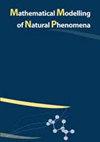Stokes流中刚性粒子的数值模拟:对一般形状粒子的润滑修正
IF 2.1
4区 数学
Q2 MATHEMATICAL & COMPUTATIONAL BIOLOGY
引用次数: 0
摘要
研究了斯托克斯流中刚性颗粒悬浮液的数值模拟问题。我们重点研究了当粒子彼此靠近时的奇异短程相互作用效应(润滑效应)在模拟中的包含。这个问题不需要引入新的假设和模型就能解决。如Lefebvre-Lepot et al. [J]。流体力学[j] . 769(2015) 369-386],关键思想是将速度和压力流动分解为奇异部分和正则部分之和。在本文中,奇异部分是用距离趋近于零时解的显式渐近展开来计算的。这种展开式类似于Hillairet和Kelai提出的渐近展开式[asymptotic Anal. 95(2015) 187-241],但更适合于悬架的数值模拟。它可以计算任何局部凸(即粒子必须是靠近接触点的凸)和规则形状的粒子。使用Hillairet和Kelai[渐近分析,95(2015)187-241]作为中间结果,我们证明了剩余部分是正则的,因为它独立于距离有界。因此,只需要少量的自由度就可以获得准确的结果。该方法在二维中测试了具有一般刚性速度的两个或三个排列的粒子簇。我们证明,正如预期的那样,收敛性与距离无关。本文章由计算机程序翻译,如有差异,请以英文原文为准。
Numerical simulation of rigid particles in Stokes flow: lubrication correction for general shapes of particles
We address the problem of numerical simulation of suspensions of rigid particles in a Stokes flow. We focus on the inclusion of the singular short range interaction effects (lubrication effects) in the simulations when the particles come close one to another. The problem is solved without introducing new hypothesis nor model. As in Lefebvre-Lepot et al. [J. Fluid Mech. 769 (2015) 369–386], the key idea is to decompose the velocity and pressure flows in a sum of a singular and a regular part. In this article, the singular part is computed using an explicit asymptotic expansion of the solution when the distance goes to zero. This expansion is similar to the asymptotic expansion proposed in Hillairet and Kelai [Asymptotic Anal. 95 (2015) 187–241] but is more appropriate for numerical simulations of suspensions. It can be computed for any locally convex (that is the particles have to be convex close to the contact point) and regular shape of particles. Using Hillairet and Kelai [Asymptotic Anal. 95 (2015) 187–241] as an intermediate result, we prove that the remaining part is regular in the sense that it is bounded independently of the distance. As a consequence, only a small number of degrees of freedom are necessary to obtain accurate results. The method is tested in dimension 2 for clusters of two or three aligned particles with general rigid velocities. We show that, as expected, the convergence is independent of the distance.
求助全文
通过发布文献求助,成功后即可免费获取论文全文。
去求助
来源期刊

Mathematical Modelling of Natural Phenomena
MATHEMATICAL & COMPUTATIONAL BIOLOGY-MATHEMATICS, INTERDISCIPLINARY APPLICATIONS
CiteScore
5.20
自引率
0.00%
发文量
46
审稿时长
6-12 weeks
期刊介绍:
The Mathematical Modelling of Natural Phenomena (MMNP) is an international research journal, which publishes top-level original and review papers, short communications and proceedings on mathematical modelling in biology, medicine, chemistry, physics, and other areas. The scope of the journal is devoted to mathematical modelling with sufficiently advanced model, and the works studying mainly the existence and stability of stationary points of ODE systems are not considered. The scope of the journal also includes applied mathematics and mathematical analysis in the context of its applications to the real world problems. The journal is essentially functioning on the basis of topical issues representing active areas of research. Each topical issue has its own editorial board. The authors are invited to submit papers to the announced issues or to suggest new issues.
Journal publishes research articles and reviews within the whole field of mathematical modelling, and it will continue to provide information on the latest trends and developments in this ever-expanding subject.
 求助内容:
求助内容: 应助结果提醒方式:
应助结果提醒方式:


